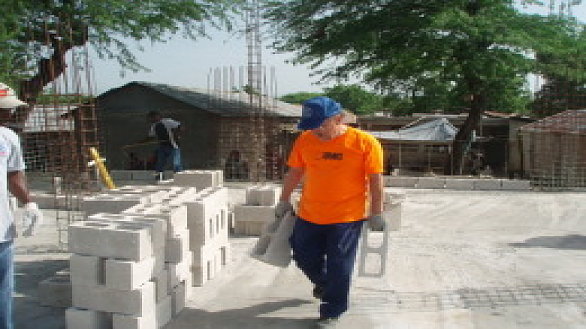Photo: Gil Hanke carries cinder blocks to build the walls of the church at La Temblay, Haiti
By Gil Hanke
LA TEMBLAY, Haiti –– This summer, I led a nine-member team to help rebuild a church here. Organized under the Texas Annual Conference, the team had six members from Texas, two from Tennessee and one from Virginia. We left the U.S. on June 27 and returned July 5.
We slept in a Methodist school and worked at the church a short walk down the road. Our team worked for the Haitian Methodist Church under the direction of Haitian masons and carpenters.
Our work was coordinated by the UM Committee on Relief (UMCOR) and UM Volunteers in Mission. Our team raised $3,500 for the project, an amount matched by UMCOR.
Those who had never been to Haiti or who had not been to the island nation since the January, 2010, earthquake were moved by the damage. Two of us who were there shortly after the earthquake were gratified by the amount of clean up and rebuilding efforts.
Our task was to be in relationship with children and adults at the school, the worksite and the community. We followed a Missouri Area team that had poured a slab for the church building and we erected concrete block walls.
I have made many trips to Haiti, usually to work in schools serving children with severe hearing impairments. Three of those schools were completely destroyed by the earthquake, and they have now reopened in different locations.
Institut Monfort, a Roman Catholic school, was a special place for us as the children were more oral than some of the other schools for the deaf. I had some difficulty connecting with them as they had moved out of the Port au Prince area.
The new location of the school was just a few miles from La Tremblay. With the help of our interpreter, I made connections with the school and two nuns from the school visited our worksite. They were initially hesitant to meet as some other visitors from the US were more interested in a photo shoot than providing assistance. Subsequently, I was invited to visit the school on Saturday afternoon. Trust was restored and they will welcome us when we make future visits to test their children and provide hearing aids.
Sunday, after many days of hard hot work at the church, we enjoyed a two-hour-plus worship service at the school. The congregation was excited to see work on their church progress. Soon they will return to a larger new facility.
That afternoon, we took Haitian staff members to a beach. For some of those who had cooked for us and taken care of us, it was their first time at a real beach.
Monday we returned to the Methodist Guest House and we toured the severely damaged city of Port au Prince. Government buildings were especially hard hit and there are tent cities in every open public space.
We visited College Bird, the “mother church” of the Methodist Church of Haiti, and a severely damaged Methodist school. We then walked around the corner to the site of St. Vincent’s School for Handicapped Children, a place I had visited on every previous trip.
The school had relocated to a building across the street.
As we stood looking at temporary wall where the school and clinic had stood, I felt a hand on my shoulder. I turned to find a teacher who had attended Saint Vincent’s due to his deafness. We embraced and he recounted in sign language his injuries and experience during the quake.
I promised to return, a promise he knows from the last 20 years I will keep.
United Methodist teams continue to come to Haiti. They work and bring in many things. Their most precious gift is hope and the physical evidence that the people of Haiti are not forgotten.
Gil Hanke is the top staff executive of the General Commission on United Methodist Men


